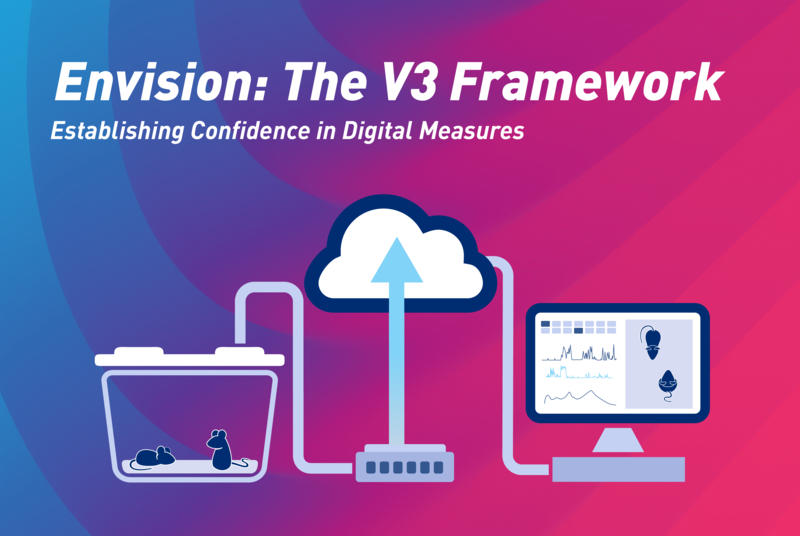The V3 Framework: Establishing Confidence in Digital Measures

Digital monitoring technology is revolutionizing biomedical research. While wearable devices have already proven invaluable for early disease detection and progression monitoring in clinical settings, The Jackson Laboratory (JAX)—a research institution with over 90 years of expertise in mouse models—is now pioneering its application in preclinical research through the innovative Envision™ platform.
Traditional preclinical research methods face several critical challenges. Manual observations are episodic, often stressful for animals, and typically limited to daytime hours, when nocturnal species like mice are least active. As a result, meaningful behaviors and physiological changes may go undetected and researchers risk missing key events leading to gaps in meaningful insights and potential oversights in study outcomes. Compounding these challenges, human presence itself can alter animal behavior, raising concerns about whether researchers are capturing true biological responses from disease or therapeutic effects, or merely the effects of human influence. These limitations create data gaps, reduce reproducibility, and compromise data quality, undermining the translational relevance of preclinical findings.
Envision addresses these limitations by providing continuous, longitudinal, and non-invasive digital monitoring that captures validated measures of animal behavior and physiology in the home-cage environment. By leveraging computer vision and AI-driven analytics in real-time, Envision enhances data quality, improves translational relevance, and supports animal welfare.
The V3 Framework: A Framework for Establishing Confidence in Digital Measures
As digital monitoring technology becomes increasingly integrated into preclinical research, ensuring the reliability and accuracy of these tools is critical. As is ensuring they provide meaningful and accurate insights into animal biology. The Digital Medicine Society (DiMe), in collaboration with academic and industry partners, has developed the V3 framework to guide the validation of digital measures in clinical research. The In Vivo V3 Framework as an adaptation specifically tailored for preclinical research was first proposed by the Digital In Vivo Alliance (DIVA) (DIVA, 2024) and more broadly adopted by DIVA and the 3Rs Collaborative’s (3RsC) Translational Digital Biomarkers (TDB) initiative, is specifically tailored for the unique challenges and requirements of preclinical animal research. This adapted framework comprises three key components: verification, analytical validation, and clinical validation, and forms the foundation for Envision’s validated digital measures of animal health and physiology.
Step 1: Verification
Verification establishes the integrity of raw data confirming the source and correct identification of sensor inputs.
In the case of Envision, computer vision sensors detect raw signals from mice, which algorithms then transform into quantitative measures of behavior and physiology. Digital sensors detect raw signals from the animal, which algorithms then transform into quantitative measures of behavioral and physiological functions. These metrics represent specific biological events and are transferred to software platforms for analysis, reporting, and visualization.
Verification includes a series of checks throughout data collection. For example, in verifying computer vision sensors, including assurance of proper illumination, maintaining contrast between animals and their background, and confirming that cameras record events from the correct cages with properly identified animals at precise timestamps. Throughout a given study, verification serves as a key quality assurance step by executing checks from initiation to completion, ensuring data integrity and confirming consistent, uncorrupted data collection within the intended period.
Step 2: Analytical Validation
Analytical validation assesses whether the quantitative metrics generated by an algorithm accurately represent the captured events in real-time, with appropriate precision and resolution. This stage often poses a unique challenge, as these technologies often measure biological events with greater temporal precision than traditional "gold standard" methods. In some cases, no direct comparator exists, particularly for novel endpoints.
To address this, researchers can use a triangulation approach, integrating multiple lines of evidence: biological plausibility, comparison to reference standards, and direct observation of measurable outputs (such as computer vision data). For instance, analytical validation may involve comparing computer vision-derived respiratory rates with plethysmography data or assessing digital locomotion measures against manual observations. While absolute values may differ, consistent response patterns to known stimuli provide confidence in the digital measure’s validity and performance. This multi-faceted approach can build stronger confidence than a single validation method alone.
Ultimately, successful analytical validation requires collaboration between machine learning scientists and biologists to establish clear definitions, such as defining "locomotion" through specific parameters like minimum distance traveled and duration, ensuring that digital measures accurately reflect biological phenomena.
Step 3: Clinical Validation
Clinical validation determines whether a digital measure is biologically meaningful and relevant to health or disease states within a specific research context. Clinical validation confirms whether a digital measure meaningfully represents an animal's health or disease status. For example, locomotor activity data in a toxicology study may serve as a relevant biomarker for assessing drug-induced central nervous system effects. Clinical validation builds upon analytical validation by demonstrating that digital measures provide insights that are both interpretable and actionable within the intended research setting.
A Transformative Future for Preclinical Research
The Jackson Laboratory's Envision platform exemplifies the transformative potential of digital monitoring technology in preclinical research. By adopting the Preclinical In Vivo V3 Framework, ensuring rigorous verification, analytical validation, and clinical validation, researchers can establish robust confidence in the Envision platform’s digital measures, improving data quality, translational relevance, and an improved understanding of the quality of life of the animal. As the platform continue to evolve, it promises to reshape preclinical research, driving more precise, ethical, and impactful scientific discoveries.